Hermaea cf. bifida
(Montagu, 1815)
Order: SACOGLOSSA
Superfamily: LIMAPONTIOIDEA
Family: Hermaeidae
RELATED TOPIC
This Japanese record seems very similar to the Nthn European [Atlantic] species. Perhaps an artificial distribution?
Authorship detailsRudman, W.B., 2002 (May 7) Hermaea cf. bifida (Montagu, 1815). [In] Sea Slug Forum. Australian Museum, Sydney. Available from http://www.seaslugforum.net/find/hermcfbifi
Related messages
Re: Hermaea sp? from Okinawa
April 20, 2006
From: Cynthia Trowbridge
Concerning message #12489:
Dear Bill and colleagues,
It was of considerable excitement to read about the Hermaea cf. bifida from various Asian locations, including Okinawa, where I have been working since 2002 with Yoshi and Yakko Hirano (Chiba University). We are presently working on a manuscript on sacoglossan species that feed on red algae, hence my particular interest in the Hermaea reports. This message is intended as a focal point for discussion, not a viewpoint (as I have never collected the Asian Hermaea cf. bifida ).
First some background:
Of the Hermaea species that feed on red algae, perhaps the most abundant one is the NE Atlantic Hermaea bifida (Montagu, 1815). Uncommon to rare congeners include Hermaea variopicta (Costa, 1869), H. paucicirra Pruvot-Fol, 1953 and H. boucheti Cervera et al., 1991 on NE Atlantic shores; H. cruciata Gould, 1870 on NW Atlantic shores; H. coirala Marcus, 1955 on SW Atlantic shores; Hermaea oliviae (MacFarland, 1966) on NE Pacific shores; H. noto (Baba, 1959) on NW Pacific shores; and H. evelinemarcusae Jensen, 1993 on Australian shores. Numerous additional Hermaea sp. have been recorded, particularly in the Indo-Pacific region (e.g., Carlson & Hoff, 2003).
Bill, when you called the Asian specimens "cf. bifida", did you select that bifida as the morphologically most similar species or the most well known Hermaea species? I personally was not aware of half of the species just listed until I started to investigate these red algal feeders. With all these locally distributed species around the world, I think an overlooked endemic species may be as plausible as an introduced one.
Suggestion:
In 2001, Kathe transferred Aplysiopsis oliviae to Hermaea oliviae, based on shape of radular teeth (message #5616). Recently, when reading Ichikawa (1993), I thought of Kathe's genus change and wondered if it might apply to another species: Aplysiopsis wrangeliae Ichikawa, 1993. This species feeds on the genus Wrangelia, a filamentous red alga related to Griffithsia and other Ceramialean reds. Regretfully, Ichikawa did not illustrate the radula of her species so we cannot see if it could also be moved to Hermaea. A few weeks ago, I wrote to Ichikawa; all her specimens are at the Natural History Museum in Vienna [not at Seto Marine Biological Laboratory or in Ichikawa's own collection].
I bring this species to the attention of Forum folks because "Hermaea cf. bifida" specimens may belong to this species. The rhinophores should have 3 distinctive stripes. The photos submitted to date do not appear to have the stripes but additional close-up photos of the anterior region would be great (easier said than done for small animals); Ichikawa reports the holotype as 10 mm so it is an intermediate-sized sacoglossan. If someone in or near to Vienna could check the specimens (I have written but have received no response), we may be able to solve the mystery of whether this Okinawan species should be Aplysiopsis wrangeliae or Hermaea wrangeliae. If I learn additional information about the Okinawan species, I will let folks know. In the interim, please understand that this is merely a suggestion of possible identification. I look forward to hearing other people's thoughts.
ICHIKAWA, M. 1993. Saccoglossa (Opisthobranchia) from the Ryukyu Islands. Publications of the Seto Marine Biological Laboratory, 36: 119-139.
Cordially,
Cynthia
trowbric@yahoo.com
Trowbridge, C.D., 2006 (Apr 20) Re: Hermaea sp? from Okinawa. [Message in] Sea Slug Forum. Australian Museum, Sydney. Available from http://www.seaslugforum.net/find/16344Dear Cynthia,
Thanks for your comments. Firstly I use the 'cf.' convention as a neutral comment meaning 'refer to' or 'compare to'. Some colleagues have suggested I should us 'aff' but that means 'affinity to' which definitely suggests a phylogenetic relationship to the species named. So Hermaea cf. bifida on the Forum means nothing more than 'here is a species which looks a bit like Hermaea bifida but it could be something quite unrelated'. In fact its possible that there are two species on the Hermaea cf. bifida page.
Best wishes,
Bill Rudman
Hermaea sp? from Okinawa
March 25, 2004
From: Kunihiro Takahashi
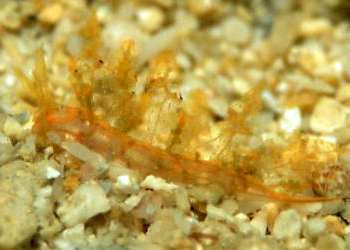
Dear Dr.Rudman,
I found this at Okinawa.
I think this is Hermaea?.
Could you identify this please?
Date: 16 Feb,2003
Location: Sunabe,Okinawa Japan
Depth: 20m
Length: 10mm
W/Temp: 21C degree
Photo by Kunihiro Takahashi
Best Regards,
Kunihiro Takahashi
manta9216@tontonme.ne.jp
Takahashi, K., 2004 (Mar 25) Hermaea sp? from Okinawa. [Message in] Sea Slug Forum. Australian Museum, Sydney. Available from http://www.seaslugforum.net/find/12489Dear Kunihiro,
This certainly looks like a species of Hermaea - possibly the one we have been calling Hermaea cf. bifida.
Best wishes
Bill Rudman
Hermaea bifida? from Korea
December 1, 2003
From: Dong Bum Koh
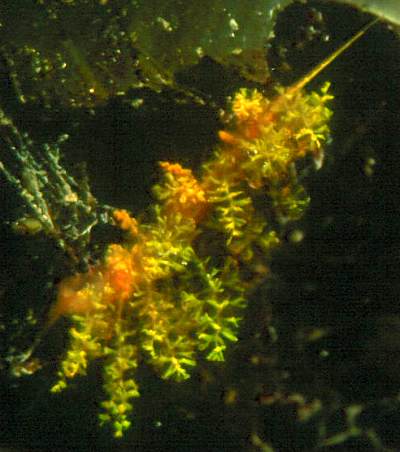
Dear Bill,
Is this a nudibranch? I am having difficulty identifying this animal. It seems to belong to the Sacoglossa and it looks like Hermaea bifida.
They are very fragile & have a slender body.
After they are touched, their body shrinks considerably. I look forward to your comments.
22. Nov. 2003 15m depth
Moon islet in Jeju island, South Korea.
Best regards,
Dong Bum Koh
drkoh@seasee.co.kr
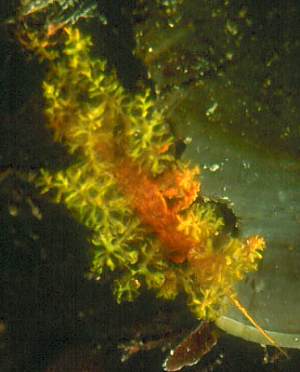
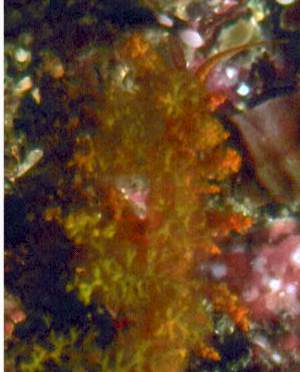
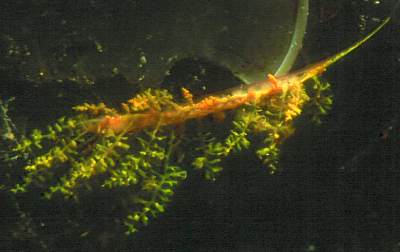
Dear Domg Bum,
When I first saw your photos I didn't realise the radiating arms were enclosed in a transparent ceratal sac. It certainly seems to be an amazing sacoglossan, and as you suggest, it is probably the same as the animal I have on the Forum from Japan as Hermaea cf. bifida. One puzzle is the apparently long rhinophores which appear to taper to a tip, which is a bit different from the rhinophores in the photo from Japan. However it is possible that the difference reflects the contracted state of the Japanese specimen.
Your animal shows an amazing similarity to a brown sea weed. I doubt if it is Hermaea bifida, but it seems to be something similar.
Best wishes
Bill Rudman
Re: Hermaea sp. from Hachijo Island Japan
May 9, 2002
From: Kathe R. Jensen
Dear Shouichi and Bill,
This animal certainly does look like Hermaea bifida. I checked Baba's paper on "stiligerids", but none of them seem to fit this animal. The other possibility is the East Pacific H. oliviae, which I have never seen alive, but judging from the picture in Dave Behrens' book (as Aplysiopsis oliviae) it is more darkly coloured. Or the West Atlantic H. cruciata, which I think has fewer lateral branches on the digestive gland tubules in the cerata.
The next question then is: How did it get there? Probably on algae in ballast water - or on "fouling" algae. This is an increasing problem, which especially for "rare" species, may completely obscure natural distributions.
Greetings,
Kathe
jensen@ait.ac.th
Jensen, K.R., 2002 (May 9) Re: Hermaea sp. from Hachijo Island Japan. [Message in] Sea Slug Forum. Australian Museum, Sydney. Available from http://www.seaslugforum.net/find/6930Thanks Kathe,
Bill Rudman
Hermaea sp. from Hachijo Island Japan
May 8, 2002
From: Shouichi Kato
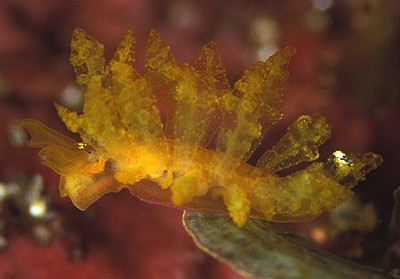
Dear Bill,
Please see the attached photo.
I found this animal on the algae. It looks very like Hermaea bifida to me, but I'm not sure. Please advice.
Date : March 2002
Depth : 5m
Size : 10mm
Best regards,
S. Kato
regulus@edit.ne.jp
Kato, S., 2002 (May 8) Hermaea sp. from Hachijo Island Japan. [Message in] Sea Slug Forum. Australian Museum, Sydney. Available from http://www.seaslugforum.net/find/6868Dear Shouichi,
It certainly looks like the Atlantic Hermaea bifida but hopefully Kathe Jensen can give us her opinion on this species
Best wishes,
Bill Rudman
